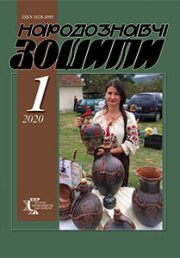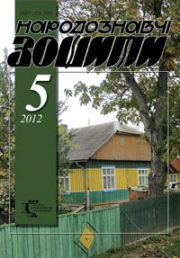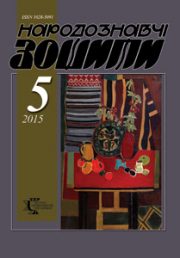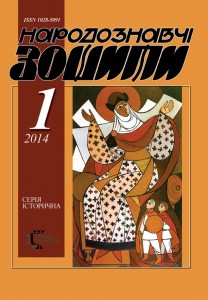2014 year, issue 1
In the article have been considered some problems as for joining of Volhynian Orthodox parishes to a nascent process of movement for revival of Ukrainian autocephalous Orthodox church (since November 1917), mass movement of Orthodox flock for introduction of Ukrainian language into liturgy, expansion of Prosvita net in towns and villages of the country and activities of Ukrainian co-operative institutions.
Keywords: Vasyl Lypkivsky, Dyonisii, Arsen Richynsky, all-Ukrainian Orthodox Counsil, Orthodoxy in Poland, Lutsk all-Volhynian Congress, Church Congresses in Volodymyr and Berestya.
Keywords: Vasyl Lypkivsky, Dyonisii, Arsen Richynsky, all-Ukrainian Orthodox Counsil, Orthodoxy in Poland, Lutsk all-Volhynian Congress, Church Congresses in Volodymyr and Berestya.
The article has presented an attempt of descriptive analytic studies in the influence of phenomenon of «instrumental mind» upon creative activity. The meanings of urban space as ontological components in this regard have been exposed.
Keywords: city, homo urbicus, reflection, «instrumental reason» (instrumentellen Vernunft), formalized reason, calculation, rational, irrational.
Keywords: city, homo urbicus, reflection, «instrumental reason» (instrumentellen Vernunft), formalized reason, calculation, rational, irrational.
The article has dealt with Jan Czekanowski’s Lviv anthropological school that was formed and headed by eminent scientist in the interwar period, mainly on the basis of staff employees’ team of Institute for Anthropology and Ethnology of Lviv University. Exposition and evaluation of scientific achievements by a large group of gifted researchers have been presented against the background of 1920s—1930s epoch.
Keywords: anthropology, Institute of Anthropology and Ethnology, Lviv University, scientific school, race, anthropological type, craniometry.
Keywords: anthropology, Institute of Anthropology and Ethnology, Lviv University, scientific school, race, anthropological type, craniometry.
In the article have been considered some problems as for contents and publishing design of Nova Khata (New House) Lviv periodical issued through 1925 to 1939. Its publications have been analyzed in the context of feminist movement as well as of the everyday private life-styles of mentioned period as reflection of interrelations between ideological motives and Ukrainian popular culture in Galicia of interwar period.
Keywords: Nova Khata, women’s press, feminism, everyday life, stereotype, history, ethnology, culture.
Keywords: Nova Khata, women’s press, feminism, everyday life, stereotype, history, ethnology, culture.
In the study based on a wide range of literary materials have been comprehensively characterised field research in Polisia of Ukraine, performed by Russian and Belarusian ethnologists during 1945—1980s as well as Moscow ethnolinguists and other researchers from ethnologic centres of Russia, Ukraine and Belarus in the course of realization of Ethnolinguistic Atlas of Polisia program. Particular attention has been paid to geography, methods, themes and research results of scientific projects.
Keywords: ethnology, etnical linguistics, Ukrainian Polisia, field explorations, methods, themes.
Keywords: ethnology, etnical linguistics, Ukrainian Polisia, field explorations, methods, themes.
In the article has been considered a problem as for the choice of Christian (first) name for a newborn baby after folklore beliefs, consuetudes and traditions spread along the territory of Opilia, as also among ancient Slavs peoples and in the whole Ukraine.
Keywords: Ukrainian traditions of naming a child, personal name, motives of the name, Opilia.
Keywords: Ukrainian traditions of naming a child, personal name, motives of the name, Opilia.
Some peculiarities of Boiko people’s imagination about so-called evil deceased have been studied in the article; magical and ritual means of counteraction and protection against evil influences have been analyzed on the basis of field data and ethnological literature.
Keywords: evil deceased, people’s demonology, demonological imagination, guard, Boikos.
Keywords: evil deceased, people’s demonology, demonological imagination, guard, Boikos.
The paper deals with a problem of ritual acts performed with the aim to put an end to protracted bad weather. Owing to analytic studies in field ethnographic data gathered during expeditions the author has determined some general thematic complexes of rites as well as beliefs lain in the essence of ones.
Keywords: wedding, weather, invitation, cat, dog.
Keywords: wedding, weather, invitation, cat, dog.
In the article have been considered several general activities by Lev Zatsny, one of leading members of the Organization of Ukrainian Nationalists on the post of organizational referee (vice-chief) in Land Headquarters of OUN; some directions in preparation of rebellion against the Soviet rule in 1940 have been found and exposed.
Keywords: Organization of Ukrainian Nationalists, Organizational Reference, insurrection, the underground network, Land Headquarters, Western region of Ukraine.
Keywords: Organization of Ukrainian Nationalists, Organizational Reference, insurrection, the underground network, Land Headquarters, Western region of Ukraine.
The article has brought some results of research-work on some features of traditional folk dress by Ukrainians of Transcarpathian region during ХІХ and first half ХХ cc. On the ground of field records, archival and literary sources, as well as of museum collections an analytic evaluation of the present-day solution of problem in historiography has been presented with tracing of ethnographic borderlines and ethnical identifying features in folk dress by Hutzuls of Rakhiv country, Transcarpathian Dolinians, all-Carpathian Ukrainian especial and peculiar lines in the clothing of Bojkos and Lemkos of Transcarpathian region. The role of borrowings from foreign — Slovak, Hungarian and Romanian neighbours and ones’ influence on formation and development of Ukrainian folk clothing along corresponding ethnical borders have also been exposed. The impact of ethnical, socio-economic, ecological and other factors on regional features of folk clothing has been defined.
Keywords: folk clothes, ethnic identifying features, ethnographic lines, material and technique of making, forms of decoration, constituents of woman and masculine complete sets of folk clothes.
Keywords: folk clothes, ethnic identifying features, ethnographic lines, material and technique of making, forms of decoration, constituents of woman and masculine complete sets of folk clothes.
Antoniv Petro. On people’s wedding feast at the village of Oslavytsya in Lemko land. P. 98-102
A traditional Lemko wedding feast has been thoroughly presented in the article written accordingly to oral narrations by persons of Oslavytsya origin: time and duration of a wedding party and its all subsequent stages, acting persons as well as their roles, functions and duties, ornamentations of a rooms, cast of musical band; examples of sung refrains have been added.
Keywords: courting, weaving of a chaplet, bridal ceremony, bride-cake, bridegroom, bride.
Keywords: courting, weaving of a chaplet, bridal ceremony, bride-cake, bridegroom, bride.
In the article have been presented and studied some peculiarities of traditional Easter rites by Ukrainian mountaineers, Bukovina Hutzuls in particular. The study has been based upon the author’s field ethnographic materials with especial exposition of tradition and rites sporadically met as for now along the mentioned territory and still being of great importance for bea¬rers of the ancient folk culture.
Keywords: ethnology, Bukovina, Hutzul land, Carpathian region, Easter, tradition, ceremony, rite(s), custom(s).
Keywords: ethnology, Bukovina, Hutzul land, Carpathian region, Easter, tradition, ceremony, rite(s), custom(s).
Popovych Yaroslava. On some methods in popularization of Zhovkva cultural heritage. P. 114-122
In the article have been studied and described several survived monuments of sacral wooden architecture in Rava-Ruska region as well as history of environment. Proposals have been forwarded as for some methods of recreation, particularly in tourism sector, that during recent years got active development due to the large number of tourists from Ukraine and from abroad.
Keywords: heritage, church, parish, craft, history, icon, nation building, values, tourism, conservation, culture, promotion and tradition, life.
Keywords: heritage, church, parish, craft, history, icon, nation building, values, tourism, conservation, culture, promotion and tradition, life.
In the article have been considered several types of chimney head-gears with corresponding architectural, constructive and decorative solutions in design; groups and sub-groups of objects have also been classified. Mentioned materials have exhaustingly been illustrated with added graphical part.
Keywords: Moldova, chimney, roof, décor.
Keywords: Moldova, chimney, roof, décor.
Molyn Valentyna. On Kolomyian exibition of home crafts (a look across past century). P. 130-136
In the article has been presented various data as for exhibition of home crafts, that took part in Kolomyia at 1912. This exhibition had been quite important event in socio-cultural life of Galicia. Catalogue and photographic illustrative materials of exhibited artifacts as well as numerous exhibits shown then to publicity still have been carefully kept in the treasuries of Kobrynsky National Museum of Hutzul and Pokutian Folk Art in Kolomyia.
Keywords: Galicia, Hutzul land, Pokutia, Kolomyia, exhibition of folk crafts, craftsmen, works of art.
Keywords: Galicia, Hutzul land, Pokutia, Kolomyia, exhibition of folk crafts, craftsmen, works of art.
Chudiyovych Ihor. Hodge-podge on beardom. P. 137-166
Presented materials have enabled acquaintance with a unique source documenting the history of forestry in Boiko land. Publication is preceded with the study on shelter for wild animals founded in the village of Pidhorodsi, Skole county by K.S. Petrusky, great landlord in this massive of Ukrainian Carpathians. As main carrier of data on hunting of the 2nd half XIX c. in the study has been presented Rev. Mykhailo Revakovych, author of Stories about the Bears and two notebook scripts of his Reminiscences. These materials have contained informative facts on traditional means of farming and hunting along the mentioned areas as well as notions quite valuable for ethnographic studies.
Keywords: hunting, shooting, wild fauna, bears, forest, fo¬restry, Rev.M.Revakovych.
Keywords: hunting, shooting, wild fauna, bears, forest, fo¬restry, Rev.M.Revakovych.
Stepan Pavluk. He offered own life to make Christ’s Church united. P. 167-170
read »
Iryna Koval-Fuchylo. On funerals in Slobidska Ukraine. P. 171-172
read »
Mykola Mushynka. Megalomania, naivety or provocation?. P. 173-183
read »







